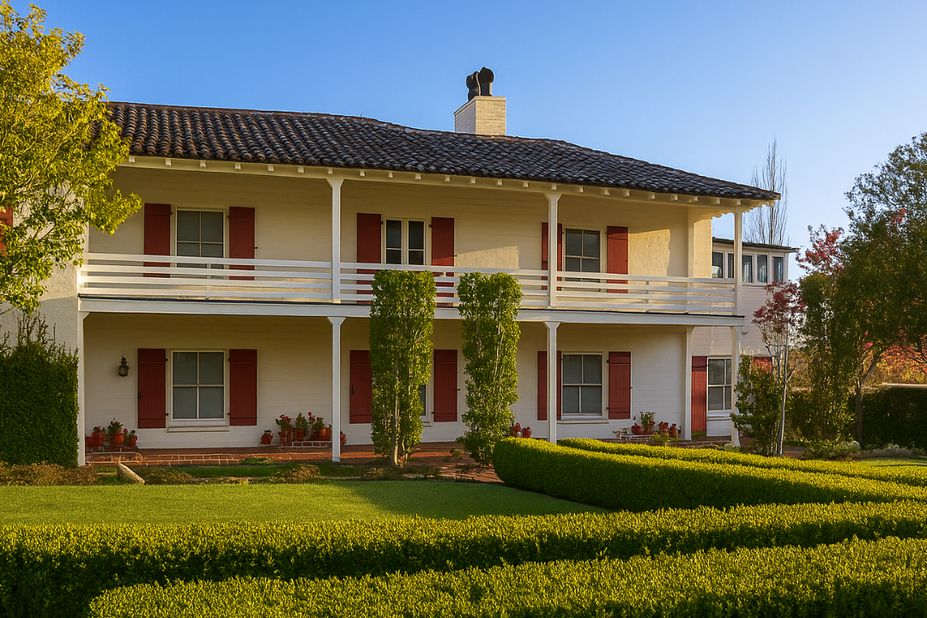By Mauricio Segura August 12, 2025

Photo: GBT Graphics
The road up is quiet by design. You leave your car in downtown Danville, board a small National Park Service shuttle, and glide into a gated neighborhood that keeps the hilltop still. At the end of the ride sits Tao House, the retreat Eugene O’Neill built with his wife, Carlotta Monterey, after he won the 1936 Nobel Prize. He called it his “final home and harbor.” Here, from 1937 to 1944, he wrote the late plays that define his legacy.
The house is a study in chosen seclusion. O’Neill and Carlotta bought a 158-acre ranch above the valley and designed the building themselves, blending a Spanish-California exterior with interiors that reflect their fascination with Asian art and ideas. Inside, deep blue ceilings suggest night, dark floors read as earth, red doors punctuate the rooms, and Chinese lacquerware and masks keep company with California light. It is both personal and theatrical, a set built for work rather than spectacle.
Work happened. In this house O’Neill completed The Iceman Cometh, Long Day’s Journey Into Night, Hughie, and A Moon for the Misbegotten. He pushed forward on an eleven-play American saga he called A Tale of Possessors, Self-Dispossessed. Drafts for A Touch of the Poet and More Stately Mansions came out of the same long days, along with the decision to burn pages from the cycle he could no longer carry. The study that anchored those hours still looks lived in, a room where concentration left marks.
If the house provided focus, the landscape provided perimeter. O’Neill had moved more than thirty times before settling here, and the isolation was a choice he took seriously. In the late 1930s and early 1940s the property stood apart from town and from the theatrical noise that followed his name. The distance helped him write about families imploding under the weight of drink, memory, and love. It is a short shuttle ride today, but the psychic gap the playwright prized is intact.
Visitors often want to know why the plays stop. The answer is medical rather than dramatic. O’Neill developed a progressive neurological disorder that made writing physically impossible after 1943. For years doctors assumed Parkinson’s disease. A later review of his autopsy concluded he suffered from late-onset cerebellar cortical atrophy, which explains the tremor that ended his ability to work by hand. Dictation did not suit him. The pen had to move.
Tao House is also a lesson in partnership. Carlotta shaped the decor and daily routines that kept distractions down and pages coming. Much of what feels distinctive about the interiors is her hand, from the color palette to the Chinese furnishings. Step into the living room and you can see how the couple built a space that reads as calm even when the writing was anything but.
The property narrowly avoided disappearance. After the O’Neills left California during the war, the house passed through private owners, and by the early 1970s demolition was on the table. Local advocates formed the Eugene O’Neill Foundation, raised funds with benefit performances, and secured landmark status. In 1976 Congress authorized the National Historic Site. By 1980 the National Park Service took over management. That chain of decisions is why a study, a courtyard, and a barn survive to tell the story.
History has not been frozen under glass. Each fall, an annual Eugene O’Neill Festival brings staged work to the property and to downtown venues, turning the site into something more than a shrine. On performance dates the park limits tours to keep the focus on the stage. The rest of the year, rangers walk you through the rooms where the late plays were set in motion.
Practicalities matter here. Because Tao House sits within a private community, no personal vehicles are allowed at the site. Reservations are required, and the free shuttle departs from the Museum of the San Ramon Valley at 205 Railroad Avenue. It is a small adjustment that keeps the setting close to what O’Neill wanted, quiet, controlled access, time to think.
If you are tempted to reduce the place to a pretty hill with a good story, the rooms argue back. The late plays came from this address not because the house is charming but because it is exact. The study emphasizes enclosure. The courtyards encourage short walks that do not break a thought. The distance from Broadway and from acquaintances makes room for pages about fathers and sons who cannot save each other and mothers who cannot be rescued by faith or chemistry. The house absorbed all of it and gave back discipline.
Tao House is a rare kind of historic site. It offers atmosphere, yes, but it also offers cause and effect. A writer built a space that allowed hard work to happen, and hard work did. A local coalition decided the space mattered, and now anyone with a reservation can see how the architecture of a day becomes the architecture of a life. If you want to understand the Bay Area’s role in American letters, a shuttle to a blue-ceilinged room above Danville is an honest place to start.
For more information: The Eugene O'Neill Foundation Tao House













